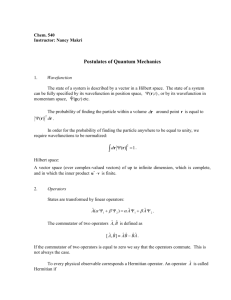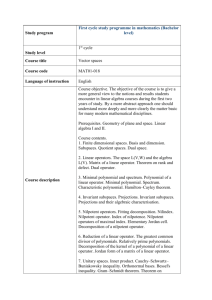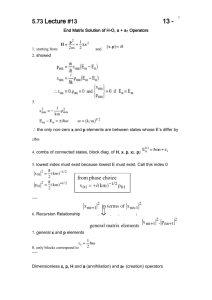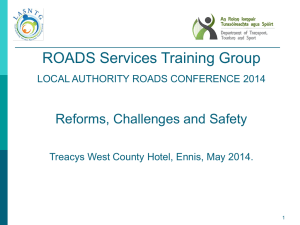Designing an Ethylene Plant Control Room and
advertisement
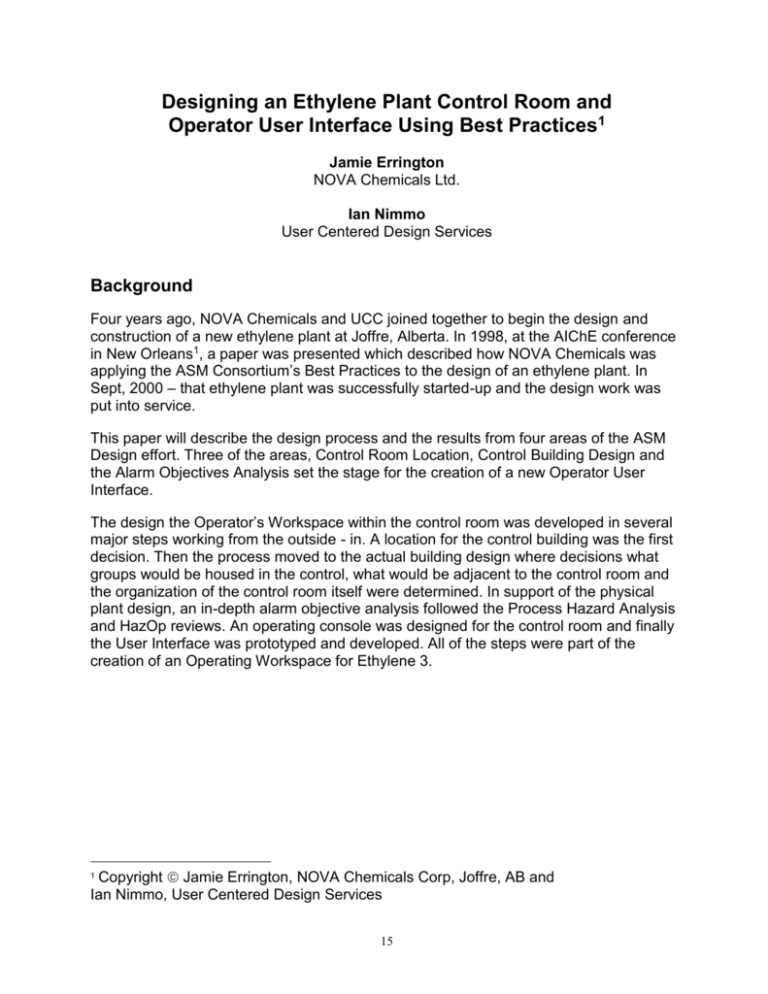
Designing an Ethylene Plant Control Room and Operator User Interface Using Best Practices1 Jamie Errington NOVA Chemicals Ltd. Ian Nimmo User Centered Design Services Background Four years ago, NOVA Chemicals and UCC joined together to begin the design and construction of a new ethylene plant at Joffre, Alberta. In 1998, at the AIChE conference in New Orleans1, a paper was presented which described how NOVA Chemicals was applying the ASM Consortium’s Best Practices to the design of an ethylene plant. In Sept, 2000 – that ethylene plant was successfully started-up and the design work was put into service. This paper will describe the design process and the results from four areas of the ASM Design effort. Three of the areas, Control Room Location, Control Building Design and the Alarm Objectives Analysis set the stage for the creation of a new Operator User Interface. The design the Operator’s Workspace within the control room was developed in several major steps working from the outside - in. A location for the control building was the first decision. Then the process moved to the actual building design where decisions what groups would be housed in the control, what would be adjacent to the control room and the organization of the control room itself were determined. In support of the physical plant design, an in-depth alarm objective analysis followed the Process Hazard Analysis and HazOp reviews. An operating console was designed for the control room and finally the User Interface was prototyped and developed. All of the steps were part of the creation of an Operating Workspace for Ethylene 3. Copyright Jamie Errington, NOVA Chemicals Corp, Joffre, AB and Ian Nimmo, User Centered Design Services 1 15 The Plant - Ethylene 3 Ethylene 3 is a 50/50 joint venture project between NOVA Chemicals and Union Carbide Corporation (UCC) that started up in August of 2000. The plant is located at the Joffre Site, in Alberta Canada where NOVA Chemicals operates two ethylene and one polyethylene plant. The Ethylene 3 project was part of an overall expansion effort that has is added a second polyethylene and steam/electricity Cogeneration facilities to the site. ASM Design Support Project NOVA Chemicals joined the Abnormal Situation Management (ASM) Consortium in 1993. The Consortium is a group of companies (including UCC) and universities with a common goal of improving how petrochemical plants manage and avoid abnormal plant upsets. Through the initial efforts of the Consortium to gain a better understanding of what abnormal situations were and their causes, the Consortium extensively examined plant sites in North America and Europe. As an improved understanding was achieved, the member companies compiled a list of “Best Practices” for their use. With the challenge of building major new facilities at Joffre, NOVA Chemicals had the opportunity of using this knowledge to support the design effort and do it “right the first time”. By building best practice elements into the design, the hope was that it would avoid going back after the commissioning phase and correcting installed systems. An ASM Design Support project was created as a sub-project team with membership from all of the major detailed design teams plus key external resources. The plan for the project was apply the ASM Best Practices and experience to areas such as: - Operator Training Systems - HazOp Support Systems - Maintenance Management Systems - Incident Reporting Systems - Instrument, Control and Safety Systems - Online Information Systems - Alarm Management - Control Room Location - Control Room Design - Operator User Interface This paper will focus on the last three of these items. 15 Control Centre Location The goal of the project was to “to build a control center that will enhance the human performance in and around the control room “2. To get the Operator Workspace design correct, the project had to determine where the control building should be located, how to design the building and then create the workspace. The methodology developed for making a decision on where to locate the control room was more complex than just selecting a space on a map. The decision included discussions on if all the existing Ethylene plants should be consolidated into a single control building, should other units on the site use a centralized control building, what would be the benefits, and what impact would a consolidated control room have on operations? The project team first did a literature search to identify what existed in the industry to indicate what are the current standards, issues and benefits. The team identified a draft ISO standard, which although it was incomplete it was a good basis for the methodology but it did not address control-building location. The only path forward was to follow sound engineering practices of good project management and identify opportunities and review possible problems. Multi-disciplined teams met and brainstormed alternative control building solutions and attempted to evaluate strengths and weaknesses of each of the proposed alternatives. Finally each solution was boiled down to 4 key areas, which were Cost, Impact on People, Safety implications, and Business opportunities or issues. The initial thoughts had expected that a remote, centralized control building, which would serve all units on the site, would be the best solution. Virtually everyone one on the team had their own preconceived ideas on what the best solution would be especially from their own units stand-point, but after this exercise the team achieved a shared vision for the buildings required and understood where and why compromises had to be made and what it would take to strengthen the identified weaknesses with the identified solution. The 3 solutions reviewed were: - Remote – Centralized Control Building - Centralized Control Building within Battery Limits - Individual Distributed Control Buildings Cost was an issue, just like any project but the team had to identify the real costs not only for the project but for the life of the plant. For example the costs associated with building a remote centralized control building did not end with the building estimate, the team identified that any centralized building would require some form of local building structure for field operators and a safe haven for maintenance and contractors particularly given the Alberta winter environment. The difference between remote and within battery limits would impact building costs, and the local solution would require a blast resistant structure, while a remote would require additional buildings. 15 Impact on people focussed on communications, collaboration, team activities, distractions, delays, reliance on technology, manning levels and placement of expertise. Safety implications looked at the compromises associated with exposure to hazards. It was argued that the closer the building was to the unit the more effective the occupants could be in operating and maintaining the plant by being closer to the hardware they manage or the people within whom they interface most frequently. It is arguable that there is less likelihood of there being an accident due to better communications between key groups of people. The closer the people are to the unit the higher the risk they run of being exposed to the consequences of the hazards of the plant should these consequences be realized. To balance these hazards it was important to consider the protection given to the people by the buildings they occupy. The closer to the hazards the more protection the buildings must provide hence, the more they would cost. Business opportunities such as optimization and speed of response to change were weighed against poor performance due to communication breakdowns, lack of teamwork, loss of knowledge and expertise. The team selected individual control buildings for this site based on the evaluation, which was more expensive but had a stronger positive impact on people particularly the stronger collaboration between field and console operations. The ethylene plants had no strong requirement to improve communications between units over and above existing solutions such as computer monitoring of other units by a single unit, use of telephones and radios. The team felt that this solution provided a better business opportunity as individuals would be focused on the business, security would be improved, increased ownership of problems, less interference and confusion less impact on common mode failures. From this initial project a new way of doing control-building projects has been established that involves an initial feasibility study to develop a shared vision between management and the primary and secondary users of the control buildings. The process involves interviewing a cross section of management, engineering and operations personnel over a one-week period. To review the current practices and opportunities to implement Best Practices, analysis of building location based on cost, people implications, safety related risk assessment with consideration of API - RP752 and a business case. The impact of the project and its alternatives on people and organization are then reviewed. An order of magnitude cost estimate is developed for each of the alternatives based on building type and square footage, identification of benefits and project risks and finally a list of recommendations covering priorities and ways of achieving long and short term vision goals. 15 Manufacturing Building Having chosen a location, the E3 team wanted to create a Manufacturing Centre that would pull together the Operations, Maintenance and Technical staff that would all contribute to the plant’s success. Hence the new building’s name was changed from Control Building to Manufacturing Centre. To make this design a reality, senior management’s view of the current situation and a challenging vision initially for the next 5 years for the unit and then for 20 years was created. Interviews with other managers, project staff and other employees identified how shared the management vision was and how much understanding the management had of what really happens at the sharp end. Interviews with Users of the building such as engineers, managers, supervisors identified how they interfaced with the process and the primary users of the building the operators. Their needs and requirements are different to the primary users as they are usually on days. The primary users were not in all cases able to articulate what the future looked like but they were a great source for revealing what works and what does not work in the existing environments at Joffre and had insight into what would and would not work in a new solution. Management interviews and on-shift observations with operators in the existing control rooms at NOVA Chemicals observing and asking casual questions to get peoples’ buy-in to the potential solution. The process was an iterative process and the design was refined by lots of reviews with this multi-disciplined team until each person understood why elements were proposed or rejected. The shared vision increased the understanding of how people do their jobs currently and how they may do them in the future, who they need to be adjacent to, who they have loose communications and collaboration with and how to design a building and rooms based on an adjacency matrix which prioritized the layout and size of rooms. The adjacency matrix also helped set how and when to segregate people to avoid disturbances such as permit issue and shift-turnover at the beginning and end of the day. Traffic flow patterns were examined so that the design allowed for view but isolated disturbances and noise. Additionally with this information a console layout was created based on supporting communications and collaboration during normal, start-up / shut-down and upset conditions. The information identified if the operators need to see each other’s screens, if they should always have eye contact, how much verbal communication is required, what shared facilities are and were are common mode failures. The Nova Chemical project is an example of how one-on-one communication and collaboration between field operators and console operators can be maintained while permitting traffic flow is contained to a segment of the building away from the console operator but near the field operators work area in the building. Figure 1 shows the 15 Ethylene 3 control room from the Field Operators work area. The permit area is immediately behind this work area. In the E3 Manufacturing Building, Supervisors and managers have an area to observe without crowding an operator, and the application development engineers can work in isolation but be close to observe and communicate with the operators during the testing and commissioning of new software applications. The other turn that the project took was that Nova Chemicals has a vision for providing tools for operators on 12-hour shifts maintain vigilance and deal with sleep deprivation in the transition from day shift to night shift. NOVA Chemicals has developed a loss prevention standard that supports the healthy body - healthy mind philosophy. Nova invested in an exercise room for operators during quite periods and at scheduled breaks to take exercise. They also have aRest Recovery Room (nap rooms) where an operator with a sleep problem can take a nap as long as the plant monitoring is covered and it is genuine and approved by the team. The operator does not get into the full sleep cycle, but in a reclined chair can get into the first couple of stages of non-REM sleep and be fit for over eleven hours of productive shift work rather than being slow to respond, sluggish for the whole shift. 15 Figure 1: E3 Control Room User Interface A major component of the Operator Workspace design for the E3 project focussed on the User Interface or graphics for the control system. The User Interface in any control system working together with the alarm system, is an essential component for the smooth and efficient operation of a plant though it is an area that is often overlooked and not thought of as “advanced control”. However, they are applications that are used more than any other in the plant. They must operate 100 % of the time and be capable of handling any number of planned and unplanned events. NOVA has developed a User Interface system translated in part on an ASM Consortium prototype developed by a group from the Honeywell Technology Center lead by Dr. Peter Bullemer. NOVA’s implementation focussed on improving the navigation and 15 presentation of information to the operators so that the displays would work in both normal and abnormal situations. The interface has been designed with a consistent set of interactions supported through a seamless user interface, whether the functionality is driven by: - the control system, - the safety instrumented systems - an advanced control application, or - the plant information system. To help the operator maintain a broad situational awareness of the most critical issues, the interface was designed in a hierarchical manner that was integrated with the Alarm Management concepts. Together the alarms and display layout would draw the attention of the operators to the most critical issues. Visual Coding A strong visual coding scheme has been used which takes into account both salience and workload. From a salience point of view – when there is important information that the operator must know, the displays are to draw their attention to that information. Certain display attributes can swamp others from gaining the operator’s attention. Motion and colour are prime examples, though for different reasons. The effect is noticeable in everyday experience when something catches your eye and diverts your attention – it is often because the thing that caught your attention was moving, or was distinct from the background or expected color. In E3, these attributes have been used to produce the perceptual effect of bringing relevant information to the foreground. When the plant is running smoothly the displays are very bland. When alarms or “offnormal” conditions occur, then the display objects change to brighter colours and may flash to attract the operator’s attention. With a comprehensive Alarm Management program that has dramatically reduced the number of alarms applied in E3, the use of colour is effective in highlighting the key information. Another component to improve the salience of information has been the choice of background colours. The displays were created with a light grey background, versus the more common black background seen in many other Control System displays. Grey backgrounds create less glare and eyestrain on the user and will allow the lighting levels in the control room to be kept at brighter levels to reduce fatigue on the Panel Operators. 15 In terms of workload, the displays have been organized so that when the operator wants to do something they can get to the correct screen quickly and rapidly take whatever action is required. A component of this is effective navigation between displays through the use of tabs. With only one or 2 selections the operator can get to any display that they require. The system has also been created to allow for the extension of the system to handle new developments such as advanced control applications, electronic operator logbook, user notifications and decision support systems. Window Management The display formats and screen locations have been chose to ensure that critical information for the operator’s current task appears in his/her field of view with little or no operator intervention. Information presented by the system, even at the request of the operator, will not obscure critical information. A tiled (non-overlapping) arrangement of views has been created so that the operator is not required to minimize or resize displays. Workstation Layout The displays created for this project are task-centric in that they have been created for specific tasks. An outline of the layout is shown in Figure 2. A Status View orients the operator to the overall state of his/her area of responsibility. In E3, there are 2 Status View displays, one for the Cracking Area and one for the Finishing Area of the plant. These area overview displays allow the operator to monitor the critical information for their area at all times and orient them to potential abnormal conditions. Components of the Status view include an overview display, Alarm Summary and trend application windows as shown in Figure 3. 15 Status View Alarm Summary Level 1 Operations View Level 2 TagNam e Level 3 S P P V O P Level 4 Figure 2: Workstation Layout Figure 3: Status View 15 The Operations View is a multifunctional schematic view used for supervisory control & monitoring. This is the operator’s principal interface during normal and abnormal operations. The Operations View is made up of 4 displays and two Trend Applications. The operator is given an increasing level of detail focussed on a smaller portion of the plant (drilldown) as the display is viewed in a clockwise rotation from the top left to bottom left quadrants. Level 2 – Unit Display The Level 2 (upper left) quadrant of the Operations View shows a level of detail approximating that found on a Process Flow Diagram. In general it represents a major functional element of the E3 process. The example shown here, the Chilling Train, Demethanizer and the Turbo-expander portion of the E3 Finishing Area is illustrated. Since the displayed area of the plant is reduced, some mechanism must be provided to allow navigation to areas not displayed. This function is fulfilled by buttons or tabs, each tab containing a view of a different (though possibly overlapping) part of the plant. The particular tabs that appear for finer levels of detail can be controlled by the selection at the higher level, tracking the physical hierarchy of the plant. Level 3 – SubUnit Displays The Level 3 (upper right) quadrant of the Operations View shows a portion of the Level 2 display with an increased level of detail approximating P&ID diagrams. In the example shown, this Level 3 display provides the operator with a detailed view of the Demethanizer. Other Level 3 displays in this set would show the Chilling Train and the Turbo-expanders. In the Level 3 displays all equipment is shown, and additional detail that would not be shown in the level 2 view is added. 15 Figure 4: Operations View Level 4 – Group Displays Associated with each Level 3 display are a series of group displays. The group display is where specific controllers and indicators are arranged that match the control loops shown in the Level 3. Detail View The DetailView (lower left) quadrant shows the details of a point, and allows the operator to make changes in the properties of that point. The default view for a (controller) point contains a bar graph with SP, OP and PV values, and both type-in and bump-up/bumpdown controls. In addition to the on-screen controls, standard keyboard functions are linked to change zone selections in the DetailView. Selecting a tag via the mouse on any display point in the Level 2, 3 or Group displays places the point in “principle focus” and displays the tag in the Detail View. Navigation Scheme The Navigation Scheme in the E3 User Interface is flat and fairly simple. In general the structure mimics the physical or logical structure of the plant. Access to all displays can be gained from ”tabs” positioned across the top row of each screen or navigation arrows within the displays. No menus are required to gain access to the displays. 15 To the extent possible, the E3 design has provided multi-purpose displays in order to limit the number of display types necessary to support the operator tasks, and the consequent need to navigate between displays. One component of the display navigation is the use of tag “focus”. When a tag on a display is selected it becomes the “principle focus” tag and is immediately displayed in the DetailView and the DetailView trend. The other Operations View displays are automatically changed to provide the operator with the displays that correspond to that particular tag. Other tags that are “associated” with the Principle Focus tag will also be highlighted. Trend Applications As shown in Figure 4 considerable screen real estate has been set aside for process trends. These are specialized applications that have been created to integrate the Process Historian and real-time information into powerful trends that the system and / or the operator can adjust to analyze what is happening in the plant. Online Information A key aspect of improving ASM practices is the timely delivery of information to support job activities. Plant information management systems have the potential to become effective performance support systems. “A performance support system is one that can provide, on-demand, at the point of need, all of the information resources required to solve a problem or perform simple or complex tasks in support”3 of the operating unit. NOVA Chemicals prototyped an XML based on-line information management system to operate in conjunction with the User Interface. However the early testing indicated that the XML approach was too complex and difficult to setup during the project. Instead, the Ethylene 3 project implemented a Web based online information system that required very little document management. The project chose to deliver three initial types of information to the operator via the User Interface. From a right mouse click on top of a tag in the User Interface, the operator is given a menu is able to obtain additional information such as: - Operating and Safety Procedures that refer to that tag - Alarm objectives analysis information - Service Request Information By selecting a topic from the online information menu, the user is presented with a Web page displaying the topic. For example an AOA request on a particular tag shows the alarm limits, potential causes, and consequences if an alarm occurs on this tag. This is used to reinforce the Alarm Management practices developed in E3. Now the operators can review the alarm analysis results and confirm what they are to do in the event of an unexpected alarm. 15 In Ethylene 3 – the belief is that the alarm and procedural information will be better maintained if it is more accessible at the Operator’s work area than if it was kept only in reference manuals. Upcoming Developments – Task- and System-based model integration In developing effective human-computer interfaces the goal is to determine what information the user needs. Two broad approaches that are generally used to determine what information should be displayed are Task- or System-based. Task analysis methods focus on the user’s mental model that is created from the tasks, plans and goals. This approach has driven almost all of NOVA’s user interface designs. System based methods by contrast, examine the functional structure of the domain (specifically, the plant or system) in or on which work must be done. This method often captures the physical and chemical. A simple comparison of the two approaches likens the Task analysis creates and shows the directions on how to get somewhere. The directions are very effective when all of the information is known and the path is clear. System analysis creates a broad map. All of the potential paths are shown on how to get from one place to another. It is less effective than the directions when all you need to do is go from A to B but it is more effective when you are not starting at A or there is road construction, or other unplanned disturbance along the direct route. When used to guide interface design . . . “Task-based approaches - are inherently user-centered (thus more likely to mesh with mental model) - provide a strong basis for info selection and prioritization - risk errors in representing real world (esp. in open systems) - risk omitting needed information and sacrificing “global” situation awareness System-based approaches - are inherently system-centered (thus more likely to accurately and completely represent real world) - provide a strong basis for ensuring information and situation awareness completeness - risk “losing” the user and/or being incomprehensible - risk information overload”4 In working in a joint research project with the University of Toronto, NSERC and Honeywell, NOVA hopes to test the integration of the 2 approaches and get the ‘best of both worlds’. Simulator testing will begin later this year to examine if an integrated approach can improve the Operators’ responses to planned and unplanned upsets on an Acetylene Hydrogenator. 15 It is believed that this integrated approach will lead us to immediate improvements to the how the key information about the operating condition of the plant can be displayed Conclusion We have described the approach and results of building a Manufacturing Centre and User Interface for NOVA Chemicals and UCC’s Ethylene 3 facility in Joffre. The strength and power of the building and work environment forms a cornerstone for the ability of the Ethylene 3 plant to avoid abnormal situations. As a part of that environment, the Operator Workspace is a platform for continued development that will help contribute to the future operation of Ethylene 3. References: Bullemer, P. and Errington, J. “Designing for Abnormal Situation Management”, AIChE Safety Session, 1998 2 Bullemer, P. and Cochran, T – Control Center Workspace Design: Practices and Guidelines Review Paper created for NOVA Chemicals Ltd. 1997 3 Ayers, M. and Kennedy, J. - NOVA Chemicals White Paper On-line Information – 1997 4 Miller, C. and Vicente, K “Unified Modeling Project - Comparative Analysis of Display Requirements Generated via Task-Based and Work Domain-Based Analyses; A Test Case Using DURESS II”, Submitted to NOVA Chemicals, 1998 1 15




